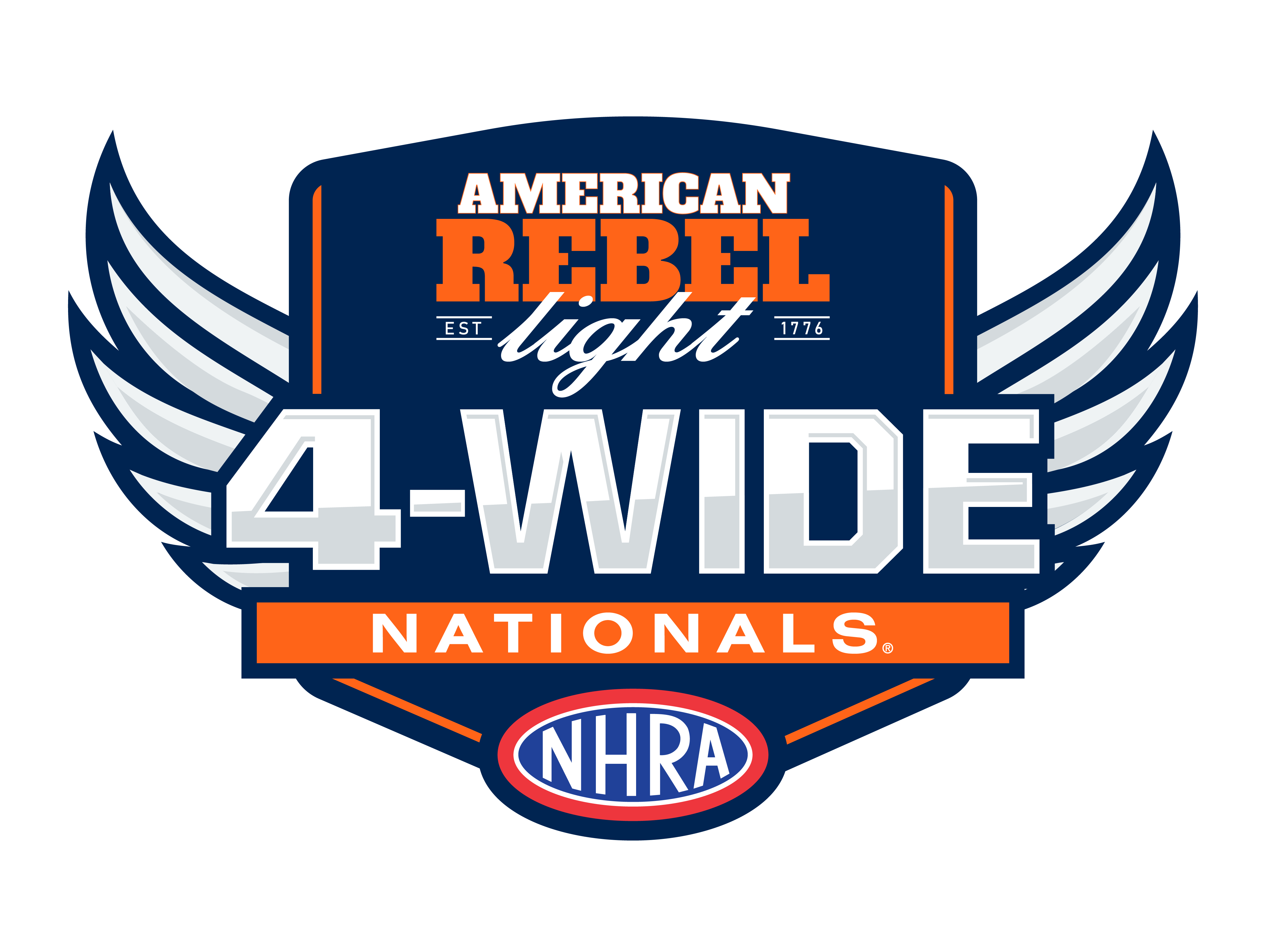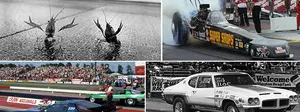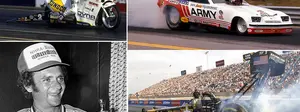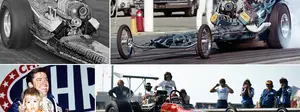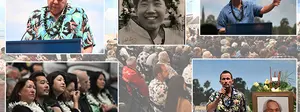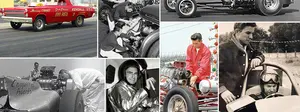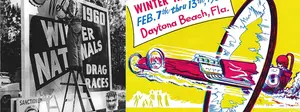

More Garlits and 'Snake'
 |
Wow, what a surprise. There are a few Don Garlits and Don Prudhomme fans out there among the Insider Nation. Who knew?
Yeah, so response to last week’s partially off-the-wall comparison of the similarities between the two Dons was a pretty big hit (even “the Snake,” his own bad self, stopped me during pre-race Sunday in Pomona to tell me he’d enjoyed it) and elicited quite a few comments from the peanut gallery, but, other than Ron Bikacsan’s note that neither are related, even by six degrees of separation to Kevin Bacon, it appears that I pretty much exhausted all of the coincidental touchpoints in their lives and careers.
Terry Kickerbocker couldn’t help but note that despite my “constant protestations” that I am “stretched to the limit” and never have enough time to do all that I need to, he thinks I have “entirely toooooo much time” on my hands to research stuff like this. Maybe so, but the truly sick thing is that I pretty much came up with about 90 percent of them in my head instead of deriving them from hours of research.
 Probably my largest investment was going through their voluminous photo files (each pretty much occupies a full file cabinet drawer) to look for photos of them together. I didn’t find as many as I expected, but reader Rich Perez passed along a few others, which you can at right.
Probably my largest investment was going through their voluminous photo files (each pretty much occupies a full file cabinet drawer) to look for photos of them together. I didn’t find as many as I expected, but reader Rich Perez passed along a few others, which you can at right.
The first image in the gallery is the cover of the February 1972 issue of Hot Rod for an article on Ed Donovan’s aluminum 417 nitro engine featuring, from left, John Wiebe, Prudhomme, Donovan, and Garlits. Wiebe, of course, got the first Donovan and made it fly, which opened the floodgates, but I was puzzled by the inclusion of Prudhomme and Garlits. Neither of them by that time had run the Donovan; Garlits, who switched to Milodon blocks in the mid-1970s, ran a Donovan briefly in 1977, but I don’t think “the Snake,” who was loyal to either Keith Black or Ed Pink, ever did.
 Looking at the magazine cover my first thought was to call photo shenanigans, at least on the Prudhomme inclusion. Wiebe has his hand on a head stud, Garlits on the blower belt, but Prudhomme almost looks like he was added into the background behind the other three. So I dragged out my copy of Hot Rod Magazine: All The Covers and found the original photo as set up by HRM Photo Editor Mike Brenner, showing the foursome posed on seamless paper (second image). Hah! Shows what I know.
Looking at the magazine cover my first thought was to call photo shenanigans, at least on the Prudhomme inclusion. Wiebe has his hand on a head stud, Garlits on the blower belt, but Prudhomme almost looks like he was added into the background behind the other three. So I dragged out my copy of Hot Rod Magazine: All The Covers and found the original photo as set up by HRM Photo Editor Mike Brenner, showing the foursome posed on seamless paper (second image). Hah! Shows what I know.
I had mentioned last week that there were three times in their careers where they entered a year tied for most wins, and one of the requests that I got was to show a year-by-year accounting of each of the Don’s wins, so you can find that in the table below. I added a third column to show Pro Stock icon Bob Glidden’s meteoric rise to the top despite giving the Dons a huge head start of about a decade.
| Year | Garlits season wins (career total) | Prudhomme season wins (career total) | Glidden season wins (career total)) |
| 1963 | 1 (1) | 0 | Did not compete |
| 1964 | 1 (2) | 0 | Did not compete |
| 1965 | 0 | 2 (2) | Did not compete |
| 1966 | 0 | 0 | Did not compete |
| 1967 | 1 (3) | 1 (3) | Did not compete |
| 1968 | 2 (5) | 0 | Did not compete |
| 1969 | 0 | 1 (4) | Did not compete |
| 1970 | 0 | 1 (5) | Did not compete |
| 1971 | 2 (7) | 0 | Did not compete |
| 1972 | 1 (8) | 0 | 0 |
| 1973 | 2 (10) | 1 (6) | 1 (1) |
| 1974 | 1 (11) | 2 (8) | 3 (4) |
| 1975 | 4 (15) | 6 (14) | 4 (8) |
| 1976 | 0 | 7 (21) | 1 (9) |
| 1977 | 1 (16) | 3 (24) | 4 (13) |
| 1978 | 2 (18) | 3 (27) | 7 (20) |
| 1979 | 3 (21) | 1 (28) | 7 (27) |
| 1980 | 0 | 2 (30) | 4 (31) |
| 1981 | 0 | 2 (32) | 3 (34) |
| 1982 | 0 | 2 (34) | 1 (35) |
| 1983 | 0 | 0 | 4 (39) |
| 1984 | 2 (23) | 0 | 2 (41) |
| 1985 | 6 (29) | 0 | 5 (46) |
| 1986 | 5 (34) | Did not compete | 6 (52) |
| 1987 | 1 (35) | 1 (35) | 8 (60) |
| 1988 | Did not compete | 2 (37) | 7 (67) |
| 1989 | Did not compete | 3 (40) | 9 (76) |
| 1990 | Did not compete | 0 | 3 (79) |
| 1991 | Did not compete | 3 (43) | 1 (80) |
| 1992 | 0 | 3 (46) | 2 (82) |
| 1993 | 0 | 0 | 2 (84) |
| 1994 | Did not compete | 3 (49) | 0 |
| 1995 | Did not compete | Retired | 1 (85) |
 |
The 1960s: Both were running in Top Fuel in the decade, and Garlits’ first win, at the 1963 Winternationals, was actually Prudhomme’s national event debut with the Greer-Black Prudhomme car. Garlits won the 1964 Nationals before Prudhomme became nationally famous by driving Roland Leong’s Hawaiian to wins at the Winternationals and Nationals in 1965.
Both went winless in 1966; it was Prudhomme’s first solo foray with the B&M Torkmaster car while Garlits was experimenting with his first 426 in the red-painted Swamp Rat 10; it’s also the year that Garlits’ father died.
Prudhomme won the Springnationals in Bristol in 1967 with sixes in the Brand Ford Special, and Garlits followed with his second Nationals win, the memorable shaving-on-the-starting-line after finally running his first six in the final with the back-in-black Swamp Rat 11. Garlits won the Springnationals and the Nationals (again!) in 1968 with Swamp Rat 12-B while “the Snake” went winless with the Shelby Super Snake.
Prudhomme won the Nationals for the second time in 1969, driving his Wynn’s Winder to victory; Garlits was driving the fateful Swamp Rat 13 and experimenting with two-speed transmissions, a combination that would maim him the following March at Lions.
The 1970s: Garlits sat out the 1970 season recuperating from his devastating injuries, and Prudhomme joined him as a three-time Indy champ that year, winning the explosively memorable final round over Jim Nicoll. Garlits was back in action in 1971 with the new rear-engine car and famously won the Winternationals in its debut as well as the Springnationals. Prudhomme was trying to run his new Hot Wheels Funny Car and the weird “slab-sided” dragster, and the split effort showed; he didn’t run but half of the events and, for the first time in his career, was first-round fodder when he did.
Prudhomme’s last full season in Top Fuel was 1972 with the Yellow Feather and the Hot Wheels wedge, and though he reached the quarterfinals on several occasions, he didn’t win. Garlits, by now heavy into AHRA and warring with Wally Parks, won the only NHRA race he entered, the Gatornationals. Garlits beat the year’s killer e.t. car, the Jack McKay New Dimension machine with Clayton Harris in the saddle, and Garlits went as far as pouring tablespoons of oil into his own headers before he fired to try to psyche Harris into thinking that his engine was wounded.
 |
Prudhomme got back into the winner’s circle in 1973 with his first Funny Car win, at the Nationals, where he became the first to win the Big Go in both nitro classes. Garlits bookended his season with wins on Prudhomme’s California home turf at the Winternationals and Supernationals. Garlits won the combo Supernationals/World Finals again in 1974 in Ontario while “the Snake” conquered Indy again and also won Garlits’ hometown Gatornationals.
Garlits had a strong 1975 with three wins and his first championship, but Prudhomme, of course, went that far better with six wins in eight events and his first title with the vaunted Army Monza. Prudhomme’s 1976 encore was seven wins in eight races and, for the first time since the 1967 Springnationals, had more career wins than Garlits, who boycotted the NHRA tour that year. Prudhomme won three more times in 1977 (including his sixth Indy) en route to his third straight championship while Garlits only ran about two-thirds of the events and scored only (again) at the Gatornationals.
Despite three more wins in 1978 and his fourth championship, it was clear that pack was closing on Prudhomme; Garlits won the Gatornationals and Indy, the latter for the fifth time. Garlits won three times in 1979 to close the decade while Prudhomme won just once, over an eight-car field at le Grandnational in Canada, and relinquished his long-worn crown to Raymond Beadle.
 |
The 1980s: Despite occasional forays into NHRA competition – most notably his 1982 runner-up to Shirley Muldowney at the Gatornationals (where she memorably ranked him as a “marginal” driver before a national TV audience) – Garlits wouldn’t win again on the NHRA trail until his Rocky-like comeback at the 1984 U.S. Nationals as he protested various NHRA rules he didn’t like and experimented with wild machines, like his sidewinder and turbine cars, and ran IHRA and AHRA events.
The early 1980s weren’t that kind to Prudhomme either. He still won his share but began to fall down the final standings chart: sixth in 1980, seventh in 1983, and a stunning 10th in 1984. Not that “the Snake” couldn’t still bring it – witness the first 250-mph Funny Car pass and unreal 5.63 in 1982 – but the killer instinct seemed to have been worn out as he went winless in 1983, 1984, and 1985, his first skunkings in a decade. “The Snake” sat out the 1986 season – his first sabbatical ever – looking for funding.
Garlits, meanwhile, had experienced a career renaissance and – in some people’s minds, including mine – almost single-handedly saved Top Fuel from extinction with his inspiring win at Indy and a follow-up at the Finals. While Prudhomme was struggling, Garlits put together back-to-back 1985-86 seasons of six and five wins and championships No. 2 and 3 while looking like the “Big Daddy” of old and opened 1987 with his 35th – and, ultimately, final – win. It was very cool for new fans of the 1980s to get a glimpse of how tough “the Old Man” used to be in his heyday.
 |
Prudhomme returned in 1987 with backing from Skoal that would last through the end of his driving career and won the Gatornationals that year, defeating the car of his longtime pal Roland Leong (Johnny West driving) in the final. He and Garlits were tied then with 345 careers win. Prudhomme got some more of his mojo back and had a top-five car from 1987 to 1988 but looked like he was all the way back in 1989, especially a national-record-setting weekend in Indy when he swept the Big Bud Shootout and his seventh and final U.S. Nationals crown.
If 1987 was Prudhomme’s comeback win, it was also the beginning of the end for Garlits. He had walked away unhurt and unfazed from his 1986 Englishtown blowover but another just before Indy in 1987 broke two ribs and injured his back. Other than a guest shot in Shirley Muldowney’s car in the opening qualifying session at the NHRA event in Dallas in late 1989 in an attempt to add a 4-Second Club membership card to his already bulging billfold (he just missed with a 5.07), he wouldn’t race again until 1992.
 |
The 1990s: With his Funny Car at the top of its game in 1989, it surprised a lot of people when he announced that he was returning to Top Fuel in 1989. He admitted he had been spooked by Don Gay Jr.’s nasty fire at the 1989 event in Denver – Prudhomme not only ran alongside him but helped pull him out of the smoldering chassis – and wanted the engine behind him, but there were other reasons.
"We had thought of doing this in 1987, but I didn't want to leave Funny Car running terrible,” he said. “I wanted to go out a winner. Now that we are running great, I can go out a winner. Top Fuel is the No. 1 class, and I want to be a part of it."
It wasn’t a warm welcome.
He backflipped his Skoal Bandit in December testing in Bakersfield and again at Le Grandnational in Canada and went winless in the season, but things got better. He opened 1991 with three runner-ups before reaching the winner’s circle in Columbus and won twice more that year (finishing third in points) and won three times again in 1992 (sixth place).
Garlits’ 1992 comeback lasted just a few runs. He competed at the Atlanta event, which Prudhomme won, but failed to qualify with his slick new monowinged Swamp Rat 32 but had unknowingly suffered detached retinas in both eyes during a two-parachute stop during pre-event testing in Gainesville. He retired (again) and turned the seat over to Bruce Larson. He’s run again this decade, just once, in a New Year’s Eve match race against Shirley Muldowney in Florida to celebrate the new millennium. He wouldn’t drive again until the 2001 U.S. Nationals, where he made his first four-second and 300-mph passes and then ran sporadically in 2002-03 before retiring (again).
Prudhomme finished out his final five seasons all in Top Fuel. After a winless 1993 campaign, his “Final Strike” retirement season was a great one with wins in Houston, Brainerd, and Dallas to take him to 49 career wins. Runner-up finishes in E-town and Topeka meant that milestone win No. 50 eluded him (although he did also win that year’s non-points Winston Invitational). He retired from driving after losing to Bob Vandergriff Jr. in round one at the Finals but went on to win Top Fuel season championships with Larry Dixon and race wins with drivers like Ron Capps, Tommy Johnson Jr., and Spencer Massey.
 |
The Glidden factor: As you can see from the chart, it didn’t take long for Glidden to catch up thanks to his rampaging Ford Pro Stockers. After a runner-up in his first final at the 1972 Supernationals, he started piling up wins beginning in 1973 like they were going out of style. Within five seasons, he has surpassed Garlits' total and within seven had topped Prudhomme.
Prudhomme had been the first to reach the once unthinkable total of 25 wins (1978 Winternationals), but Glidden was the first to reach 50 wins (1986 Dallas) and 75 wins (1989 Reading). The fact that it took him just three seasons to go from 25 to 50 is testament to just how tough he was in that era.
Glidden’s only winless season came in 1994, but, despite a heart attack in December 1994, he came back to win his 85th and final event the next year in Englishtown.
Wow, that was a lot of fun and brought back a lot of good memories. It’s amazing sometimes to try to imagine the length of their careers and the thousands and thousands of runs they have made over their careers, all of the miles they’ve traveled, places they’ve raced, work they’ve done, and fans they have thrilled over the course of two amazing lifetimes. It's no wonder they're still regarded as gods.







